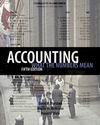 |  Accounting: What the Numbers Mean, 5/e David H. Marshall,
Millikin University
Wayne W. McManus,
International College of the Cayman Islands
Daniel F. Viele,
Webster University
Financial Statement Analysis
Chapter 11 Learning ObjectivesAfter studying this chapter, you should understand:
1.How liquidity measures can be influenced by the inventory cost-flow assumption used. |
 |  |  | 2.How suppliers and creditors use a customer's payment practices to judge liquidity. |
 |  |  | 3.The influence of alternative inventory cost-flow assumptions and depreciation methods on turnover ratios. |
 |  |  | 4.How the number of days' sales in accounts receivable and inventory are used to evaluate the effectiveness of the management of receivable and inventory. |
 |  |  | 5.The significance of the price/earnings ratio in the evaluation of the market price of a company's common stock. |
 |  |  | 6.How dividend yield and the dividend payout ratio are used by investors to evaluate a company's common stock. |
 |  |  | 7.What financial leverage is and why it is significant to management, creditors, and owners. |
 |  |  | 8.What book value per share of common stock is, how it is calculated, and why it is not a very meaningful amount for most companies. |
 |  |  | 9.How common size financial statements can be used to evaluate a firm's financial position and results of operations over a number of years. |
 |  |  | 10.How operating statistics using physical, or nonfinanical, data can be used to help management evaluate the results of the firm's activities. |
|


 2002 McGraw-Hill Higher Education
2002 McGraw-Hill Higher Education